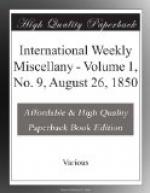“Why—why, the flame draws it up, doesn’t it?”
“Not exactly, uncle. It goes up through little tiny passages in the cotton wick, because very, very small channels, or pipes, or pores, have the power in themselves of sucking up liquids. What they do it by is called cap—something.”
“Capillary attraction, Harry,” suggested Mr. Wilkinson.
“Yes, that’s it; just as a sponge sucks up water, or a bit of lump-sugar the little drop of tea or coffee left in the bottom of a cup. But I mustn’t say much more about this, or else you will tell me I am doing something very much like teaching my grandmother to—you know what.”
“Your grandmother, eh, young sharp-shins?”
“No—I mean my uncle. Now, I’ll blow the candle out, like Moses; not to be in the dark, though, but to see into what it is. Look at the smoke rising from the wick. I’ll hold a bit of lighted paper in the smoke, so as not to touch the wick. But see, for all that, the candle lights again. So this shows that the melted wax sucked up through the wick is turned into vapor; and the vapor burns. The heat of the burning vapor keeps on melting more wax, and that is sucked up too within the flame, and turned into vapor, and burnt, and so on till the was is all used up, and the candle is gone. So the flame, uncle, you see, is the last of the candle, and the candle seems to go through the flame into nothing—although it doesn’t, but goes into several things, and isn’t it curious, as Professor Faraday said, that the candle should look so splendid and glorious in going away?”
“How well he remembers, doesn’t he?” observed Mrs. Wilkinson.
“I dare say,” proceeded Harry, “that the flame of the candle looks flat to you; but if we were to put a lamp glass over it, so as to shelter it from the draught, you would see it is round,—round sideways and running up to a peak. It is drawn up by the hot air; you know that hot air always rises, and that is the way smoke is taken up the chimney. What should you think was in the middle of the flame?”
“I should say fire,” replied Uncle Bagges.
“Oh, no! The flame is hollow. The bright flame we see is something no thicker than a thin peel, or skin; and it doesn’t touch the wick. Inside of it is the vapor I told you of just now. If you put one end of a bent pipe into the middle of the flame, and let the other end of the pipe dip into a bottle, the vapor or gas from the candle will mix with the air there; and if you set fire to the mixture of gas from the candle and air in the bottle, it would go off with a bang.”
“I wish you’d do that, Harry,” said Master Tom, the younger brother of the juvenile lecturer.
“I want the proper things,” answered Harry. “Well, uncle, the flame of the candle is a little shining case, with gas in the inside of it, and air on the outside, so that the case of flame is between the air and the gas. The gas keeps going into the flame to burn, and when the candle burns properly, none of it ever passes out through the flame; and none of the air ever gets in through the flame to the gas. The greatest heat of the candle is in this skin, or peel, or case of flame.”




